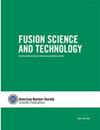HL-2M托卡马克上失控电子的LaBr 3探测器硬x射线测量研究
IF 1.2
4区 工程技术
Q3 NUCLEAR SCIENCE & TECHNOLOGY
引用次数: 0
摘要
干扰过程中产生的偏离电子对托卡马克的安全构成了重大威胁,因为它们会熔化和损坏面向等离子体的组件(pfc)。因此,研究RE行为对核聚变装置至关重要。REs与第一壁/PFCs之间的相互作用导致高能x射线的发射,称为轫致辐射。为了研究稀土的行为,有必要对硬x射线的发射进行定量评价。利用LaBr3探测器研制了一种实时硬x射线光谱仪,成功地用于HL-2M托卡马克上REs的研究。该光谱仪具有达到3 MHz的计数率能力,在662 keV (137Cs)下具有3.3%的能量分辨率。能谱的时间分辨率短至1ms。在HL-2M放电过程中,对硬x射线能谱进行了观测,通过分析250 ~ 750 keV能量范围内的能谱,推导出相应REs的温度。关键词:HL-2M托卡马哈德x射线光谱仪labr3探测器感谢西南物理研究所中子通量监测小组的帮助。披露声明作者未报告潜在利益冲突。本工作受科技部国家MCF能源研究与发展计划资助[批准号:no. 81111@166.com]。2022 yfe03080003]。本文章由计算机程序翻译,如有差异,请以英文原文为准。
Hard X-ray Measurement with LaBr 3 Detector for the Study of Runaway Electrons on the HL-2M Tokamak
AbstractRunaway electrons (REs) generated during disruptions pose a significant safety threat to tokamaks, as they can melt and damage the plasma-facing components (PFCs). Therefore, studying RE behavior is crucial for fusion devices. The interaction between REs and the first wall/PFCs results in the emission of high-energy X-rays, known as bremsstrahlung. To investigate RE behavior, it is necessary to quantitatively evaluate the emission of hard X-rays. A real-time hard X-ray spectrometer, utilizing a LaBr3 detector, has been successfully developed for studying REs on the HL-2M tokamak. This spectrometer has a counting rate capability reaching 3 MHz, with an energy resolution of 3.3% at 662 keV (137Cs). The time resolution for energy spectrums is as short as 1 ms. During the HL-2M discharge, observations were made on the hard X-ray energy spectrum, and by analyzing the spectrum within the energy range of 250 keV to 750 keV, the temperature of the corresponding REs was deduced.Keywords: HL-2M tokamakhard X-ray spectrometerLaBr3 detector AcknowledgmentsIt is a pleasure to acknowledge the assistance from the Neutron Flux Monitor team of the Southwestern Institute of Physics.Disclosure StatementNo potential conflict of interest was reported by the authors.Additional informationFundingThis work is supported by the National MCF Energy Research and Development Program of the Ministry of Science and Technology of China [grant no. 2022YFE03080003].
求助全文
通过发布文献求助,成功后即可免费获取论文全文。
去求助
来源期刊

Fusion Science and Technology
工程技术-核科学技术
CiteScore
2.00
自引率
11.10%
发文量
60
审稿时长
3 months
期刊介绍:
Fusion Science and Technology, a research journal of the American Nuclear Society, publishes original research and review papers on fusion plasma physics and plasma engineering, fusion nuclear technology and materials science, fusion plasma enabling science technology, fusion applications, and fusion design and systems studies.
 求助内容:
求助内容: 应助结果提醒方式:
应助结果提醒方式:


